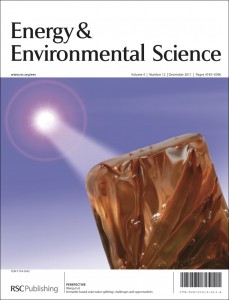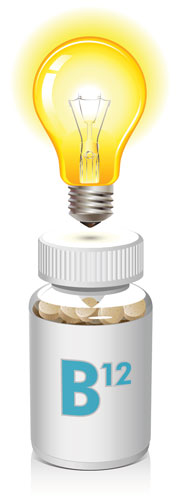Read this ‘HOT’ paper:
Reviving rechargeable lithium metal batteries: enabling next-generation high-energy and high-power cells
Aruna Zhamu, Guorong Chen, Chenguang Liu, David Neff, Qing Fang, Zhenning Yu, Wei Xiong, Yanbo Wang, Xiqing Wang and Bor Z. Jang
Energy Environ. Sci., 2012, DOI: 10.1039/C2EE02911A
Reviving rechargeable Li batteries
Bioethanol from waste paper
‘HOT’ EES paper
This paper by scientists at Imperial College London, UK provides a techno-economic analysis using new experimental data and process simulation, which shows economic feasibility for bioethanol from waste papers.
Technology performance and economic feasibility of bioethanol production from various waste papers
Lei Wang, Mahdi Sharifzadeh, Richard Templer and Richard J. Murphy
Energy Environ. Sci., 2012, DOI: 10.1039/C2EE02935A
EES highlighted in Science Watch
Energy & Environmental Science (EES) has featured in Thomson Reuters’ Science Watch this week – being highlighted as a ‘prominent journal’ in the field of Energy & Fuels.
EES publishes insightful, very high-quality science of significant general interest to the journal’s wide readership. It’s very high Impact Factor of 9.49, ranks EES the #1 journal in its field.
Read more on Science Watch
Be part of the EES community – follow us on Facebook or Twitter @EES_journal
Or submit your best reseach today!
Unique globular structures for energy storage applications
‘HOT’ EES Communication
Globular structures of rGO-MO composites produced by spray pyrolysis method were employed to fabricate high performance supercapacitor electrodes.
In situ spray pyrolysis approach to fabricate metal oxide-graphene composites with highly porous morphologies. The materials exhibited unique globular structures comprising metal oxide nanoparticles embedded between graphene sheets with high capacitance.
Read the ‘HOT’ Communication today:
Globular reduced graphene oxide-metal oxide structures for energy storage applications
Alfred Chidembo, Seyed Hamed Aboutalebi, Konstantin Konstantinov, Maryam Salari, Brad Winton, Sima Aminorroaya Yamini, Ivan P. Nevirkovets and Hua Kun Liu
Energy Environ. Sci., 2012, DOI: 10.1039/C1EE02784K
EES Issue 12 out now!
 The latest issue of Energy & Environmental Science is now online. You can read the full issue here:
The latest issue of Energy & Environmental Science is now online. You can read the full issue here:
The outside front cover features an Perspective article on Hematite-based solar water splitting: challenges and opportunities by Yongjing Lin, Guangbi Yuan, Stafford Sheehan, Sa Zhou and Dunwei Wang.
Issue 12 contains the following Review and Perspective articles:
In-depth Reviews:
- Electrospinning: designed architectures for energy conversion and storage devices
- Sustainable chlorine recycling via catalysed HCl oxidation: from fundamentals to implementation
- Porous one dimensional photonic crystals: novel multifunctional materials for environmental and energy applications
- Electroactive biofilms: Current status and future research needs
Perspetives:
- Upconverter solar cells: materials and applications
- Accelerated computational discovery of high-performance materials for organic photovoltaics by means of cheminformatics
- Hematite-based solar water splitting: challenges and opportunities
- Solution-processed colloidal quantum dot photovoltaics: A perspective
- Magnesium nanocrystal-polymer composites: A new platform for designer hydrogen storage materials
- Live wires: direct extracellular electron exchange for bioenergy and the bioremediation of energy-related contamination
- Bacteria-based biocomputing with Cellular Computing Circuits to sense, decide, signal, and act
Fancy submitting an article to EES? Then why not submit to us today!
Top ten most-read EES articles in October
This month sees the following articles in EES that are in the top ten most accessed in October:
Challenges in the development of advanced Li-ion batteries: a review
Vinodkumar Etacheri, Rotem Marom, Ran Elazari, Gregory Salitra and Doron Aurbach
Energy Environ. Sci., 2011, 4, 3243-3262
DOI: 10.1039/c1ee01598b
Review of solutions to global warming, air pollution, and energy security
Mark Z. Jacobson
Energy Environ. Sci., 2009, 2, 148-173
DOI: 10.1039/b809990c
Polarizable energy-storage membrane based on ionic condensation and decondensation
Xian Ning Xie, Kian Keat Lee, Junzhong Wang and Kian Ping Loh
Energy Environ. Sci., 2011, 4, 3960-3965
DOI: 10.1039/c1ee01841h
Graphene based new energy materials
Yiqing Sun, Qiong Wu and Gaoquan Shi
Energy Environ. Sci., 2011, 4, 1113-1132
DOI: 10.1039/c0ee00683a
Porous carbon nanofiber–sulfur composite electrodes for lithium/sulfur cells
Liwen Ji, Mumin Rao, Shaul Aloni, Lei Wang, Elton J. Cairns and Yuegang Zhang
Energy Environ. Sci., 2011, Advance Article
DOI: 10.1039/c1ee02256c
Organic tandem solar cells: A review
Tayebeh Ameri, Gilles Dennler, Christoph Lungenschmied and Christoph J. Brabec
Energy Environ. Sci., 2009, 2, 347-363
DOI: 10.1039/b817952b
Recent developments in nanostructured anode materials for rechargeable lithium-ion batteries
Liwen Ji, Zhan Lin, Mataz Alcoutlabi and Xiangwu Zhang
Energy Environ. Sci., 2011, 4, 2682-2699
DOI: 10.1039/c0ee00699h
A lithium–air capacitor–battery based on a hybrid electrolyte
Yonggang Wang, Ping He and Haoshen Zhou
Energy Environ. Sci., 2011, Advance Article
DOI: 10.1039/c1ee02121d
Nitridated TiO2 hollow nanofibers as an anode material for high power lithium ion batteries
Hyungkyu Han, Taeseup Song, Jae-Young Bae, Linda F. Nazar, Hansu Kim and Ungyu Paik
Energy Environ. Sci., 2011, 4, 4532-4536
DOI: 10.1039/c1ee02333k
Control of the nanoscale crystallinity in mesoporous TiO2 shells for enhanced photocatalytic activity
Ji Bong Joo, Qiao Zhang, Michael Dahl, Ilkeun Lee, James Goebl, Francisco Zaera and Yadong Yin
Energy Environ. Sci., 2012, Advance Article
DOI: 10.1039/c1ee02533c
Fancy submitting an article to EES? Then why not submit to us today!
UK-Singapore Symposium: New Approaches to Emerging Energy Systems
UK-Singapore Symposium: New Approaches to Emerging Energy Systems
12 – 13 January 2012
Singapore
Deadline for poster abstract: 4th January 2012
Registration deadline: 9th January 2012
Register today for free
International Speakers:
The UK invited speakers:
- Professor James Barber (Imperial College London)
- Professor Shanwen Tao (University of Strathclyde)
- Dr Adrian Fisher (University of Cambridge)
- Dr Alison Parkin (University of Oxford)
- Dr John Varcoe (University of Surrey)
- Dr Eileen Yu (Newcastle University)
The Singapore invited speakers:
- Professor Li Chang Ming (Nanyang Technological University)
- Professor Chan Siew Hwa (Energy Research Institute at NTU)
- Professor Lin Jianyi (A*STAR Institute of Chemical and Engineering Sciences)
- Assistant Professor Chen Xiaodong (Nanyang Technological University)
- Assistant Professor Fan Hongjin (Nanyang Technological University)
- Assistant Professor Ng How Yong (National University of Singapore)
In addition, Philip Earis, Editor of Energy and Environmental Science will be giving a short talk during this symposium.
Markus Antonietti joins EES Advisory Board
 Energy & Environmental Science is delighted to announce that Professor Markus Antonietti of the Max Planck Institute of Colloids and Interfaces, has joined our Advisory Board.
Energy & Environmental Science is delighted to announce that Professor Markus Antonietti of the Max Planck Institute of Colloids and Interfaces, has joined our Advisory Board.
Markus’ interests include the synthesis of novel polymers and sol-gel materials, green chemistry and carbon negative chemistry cycles as well as energy materials and artificial photosynthesis.
Professor Antonietti’s recent EES communication has been attracting lots of interest! Read it today:
Sulfur-mediated synthesis of carbon nitride: Band-gap engineering and improved functions for photocatalysis
Jinshui Zhang, Jianhua Sun, Kazuhiko Maeda, Kazunari Domen, Ping Liu, Markus Antonietti, Xianzhi Fu and Xinchen Wang
DOI: 10.1039/C0EE00418A
Giving fuel cells a vitamin boost
With the increasing energy demands of the 21st century creating a pressing interest in alternative power sources, the demand for high performing, state-of-the-art fuel cells has never been greater. However, these fuel cells require the precious metal platinum to generate their high power output, and this drawback has led scientists in Taiwan to develop a competitive replacement by combining carbon, and curiously, vitamin B12.
‘The limited abundance of platinum and other noble metals on Earth restricts the development of fuel cells. Searching for a non-noble-metal catalyst is a major issue,’ explains Kuei-Hsien Chen, from the Institute of Atomic and Molecular Science, Taipei, who, along with other colleagues, has developed this peculiar solution.
In order to generate electricity, most modern fuel cell devices require an oxygen reduction reaction (ORR) at the cathode of the cell, whilst simultaneously, another chemical (often hydrogen) is oxidised at the anode. This redox reaction for power generation has been limited by the slow ORR process, which in nature requires complex enzymes to proceed at any meaningful rate.
Although scientists have been investigating methods for speeding up the ORR, it has been notoriously difficult to produce a cathode that can achieve this and so they have had to resort to loading high amounts of expensive platinum onto the cathode to generate the required ORR rate.
However, Chen and co-workers have dispensed with the need for platinum altogether, by using cheap carbon that has vitamin B12 dispersed throughout, to form the cathode of their polymer electrolyte fuel cell (PEFC). The performance of this cathode doesn’t quite match that of platinum based cathodes, but at a fraction of the cost, this cathode could open up real opportunities for the practical application of these fuel cells.
Fuel cell expert John Varcoe, from the University of Surrey, UK, thinks that Chen’s advance clearly shows ‘promise for use as a fuel cell catalyst’, however, he urges caution by noting that the fuel cell’s performance over ‘many thousands of hours will need to be demonstrated before it will rival current (more expensive) fuel cell catalysts’.
Chen hopes to continue to develop his PEFC to make the cathode more effective, but in the meantime, this research may make fuel cells more accessible as a power source for the world’s future energy needs.
Ross McLaren
Read the paper from Energy & Environmental Science:
Vitalizing fuel cells with vitamins: pyrolyzed vitamin B12 as a non-precious catalyst for enhanced oxygen reduction reaction of polymer electrolyte fuel cells
Sun-Tang Chang, Chen-Hao Wang, He-Yun Du, Hsin-Cheng Hsu, Chih-Ming Kang, Chia-Chun Chen, Jeffrey C. S. Wu, Shi-Chern Yen, Wen-Fei Huang, Li-Chyong Chen, M. C. Lin and Kuei-Hsien Chen
Energy Environ. Sci., 2011
DOI: 10.1039/c1ee01962g
EES Issue 11 out now!
The latest issue of Energy & Environmental Science is now online. You can read the full issue here:

The outside front cover features an article on High and selective CO2 uptake, H2 storage and methanol sensing on the amine-decorated 12-connected MOF CAU-1 by Xiaoliang Si, Chengli Jiao, Fen Li, Jian Zhang, Shuang Wang, Shuang Liu, Zhibao Li, Lixian Sun, Fen Xu, Zelimir Gabelica and Christoph Schick.

Metabolite-based mutualism between Pseudomonas aeruginosa PA14 and Enterobacter aerogenes enhances current generation in bioelectrochemical systems is the article highlighted on the inside front cover by Arvind Venkataraman, Miriam A. Rosenbaum, Sarah D. Perkins, Jeffrey J. Werner and Largus T. Angenent.
Issue 11 contains the following Perspective and Review articles – take a look at these exciting feature articles:
- On the electrical conductivity of microbial nanowires and biofilms
- From Ni-YSZ to sulfur-tolerant anode materials for SOFCs: electrochemical behavior, in situ characterization, modeling, and future perspectives
- Organic solar cells: A new look at traditional models
- Membrane-based production of salinity-gradient power
- Precipitation estimates for hydroelectricity
- Chemical solutions for the closed-cycle storage of solar energy
- Theoretical studies of dye-sensitised solar cells: from electronic structure to elementary processes
Fancy submitting an article to EES? Then why not submit to us today!















